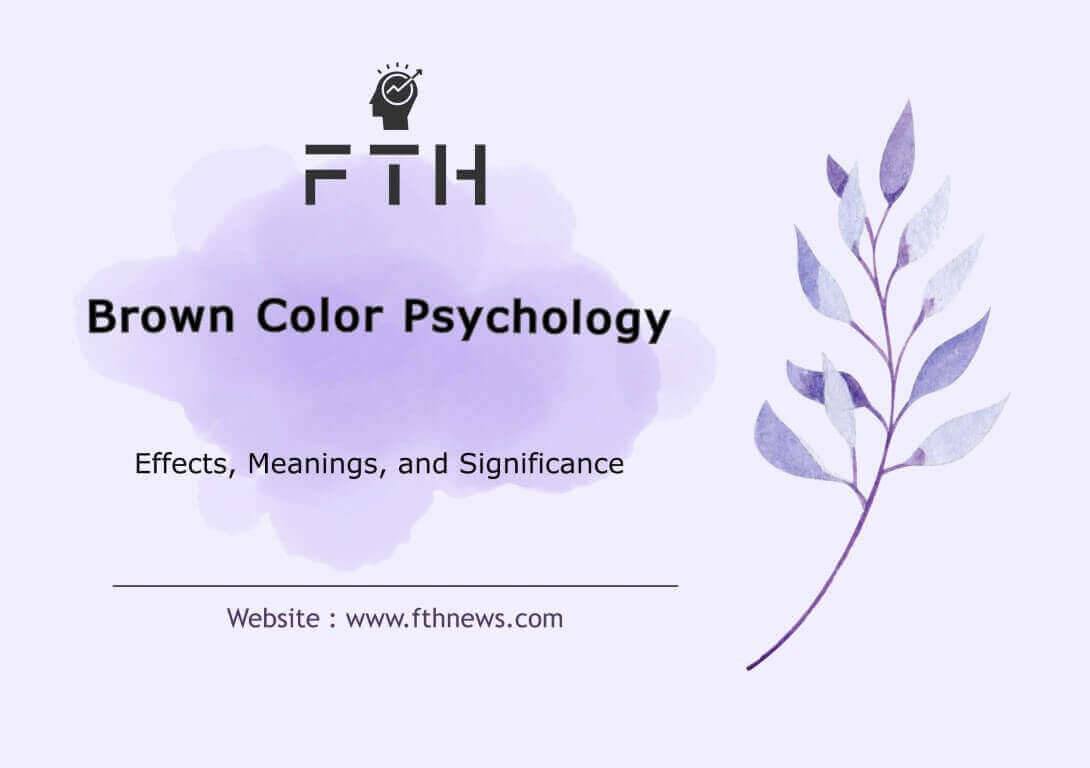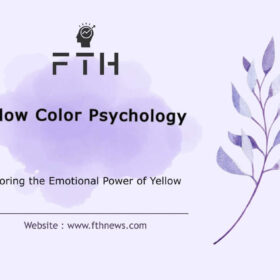
Brown Color Psychology: Colors play a crucial role in our lives, often influencing our emotions and behaviors in subtle yet powerful ways. Among these, brown stands out for its unique ability to convey a sense of reliability, stability, and comfort. In this comprehensive guide, we will delve deep into the psychology of the color brown, exploring its meanings, effects, and applications in various aspects of life. Whether you’re a marketer, designer, or simply curious about color psychology, understanding the implications of brown can provide valuable insights.
The Psychology of Brown: What Does It Mean?
Brown Color Psychology is included in the category of neutral colors and is considered a warm color. It is often associated with the earth and nature, evoking a sense of grounding and stability. Brown is a combination of various colors, including orange, yellow, red, green, blue, and purple. Depending on which of these colors is more dominant, the characteristics and meaning of brown can change slightly. Here are some key psychological associations with the color brown:
1. Brown Color Psychology: Reliability and Stability
Brown is seen as a reliable and strong color, often associated with resilience and dependability. It’s the color of the earth, which serves as a solid foundation beneath our feet. This association makes brown a color that signifies strength and steadfastness. Brands and individuals often use brown to convey a sense of trustworthiness and reliability.
2. Brown Color Psychology: Warmth and Comfort
The warmth of brown can make it feel cozy and inviting. It is the color of many natural materials like wood and leather, which are frequently used in home furnishings to create a warm, welcoming environment. This makes brown a popular choice for creating a comfortable and homely atmosphere. Brown’s natural connection also links it to feelings of intimacy and relaxation.
3. Simplicity and Practicality
Brown is a practical, down-to-earth color that doesn’t seek attention. It represents simplicity and a straightforward approach to life. This makes it a preferred color for those who value functionality and practicality over flamboyance. Brown’s understated nature can make it a perfect backdrop for highlighting other features or colors without overwhelming them.
4. Security and Protection
Brown’s grounding qualities evoke feelings of safety and protection. It can create a sense of security and well-being, making it an excellent choice for environments where a stable and secure atmosphere is desired. Whether in interior design, branding, or personal fashion, brown can help create a reassuring and protective environment.
5. Honesty and Loyalty
Brown symbolizes honesty and loyalty, making it a color associated with people who are dependable and trustworthy. This quality makes brown an excellent choice for brands and businesses that want to project a sincere and honest image. It is a color that people associate with genuineness and integrity.
6. Natural and Organic
Brown’s connection to the earth links it to nature and organic products. It is often used to represent eco-friendliness and sustainability. Products packaged in brown or branded with brown elements can convey a message of natural, organic quality. This is why many organic and health-focused brands use brown in their branding to suggest wholesomeness and environmental consciousness.
7. Maturity and Strength
Brown is also a color that symbolizes maturity and strength. It is often seen as a color of experience and reliability, suggesting a stable and wise nature. This makes it suitable for contexts where maturity and depth of character are valued.
8. Versatility and Neutrality
As a neutral color, brown can be versatile in its use. It can serve as a primary color or a complement to other colors, adding depth and richness to a palette. Its neutrality makes it adaptable for various design purposes, from creating a modern, minimalist look to enhancing a rustic, traditional style.
Understanding these psychological associations with brown can help you utilize this color more effectively in various domains, from interior design and fashion to marketing and branding. Embrace the diverse implications of brown to create environments and experiences that resonate with the desired emotions and perceptions.
Brown Color Psychology In Marketing and Branding
Brands that want to project an image of reliability and trustworthiness often incorporate brown into their color schemes. The color brown conveys a message of dependability and efficient service. For example, UPS’s brown uniforms and trucks are iconic symbols of their commitment to reliable delivery services. Brown can be used in marketing to appeal to consumers who value quality, tradition, and a connection to the natural world.
Famous Brands Using Brown:
- UPS: The brown uniforms and trucks of UPS symbolize dependability and efficient service, reinforcing the brand’s image as a reliable logistics company.
- Gloria Jean’s Coffees: This brand uses brown to evoke the warmth and richness of coffee, creating a cozy and inviting brand image.
- M&M’s: The brown packaging of M&M’s highlights the rich, chocolatey quality of the product, suggesting a premium and indulgent treat.
- Cotton: By using brown, Cotton emphasizes its connection to natural and organic products, appealing to environmentally conscious consumers.
Brown in branding communicates stability, reliability, and a deep connection to nature and organic products. It is particularly effective for brands that wish to convey honesty, dependability, and quality.
Brown Color In Interior Design
Brown is one of the most popular classic colors used in interior decoration. It creates a warm, relaxing, and inviting atmosphere, making spaces feel cozy and pleasant. The versatility of brown allows it to be paired beautifully with other colors, such as gray, silver, and beige, to create modern and sophisticated designs.
Key Points:
- Warmth and Comfort: Brown adds a sense of warmth and coziness to any space, making it ideal for living rooms, bedrooms, and other areas meant for relaxation.
- Versatility: Brown’s neutral quality makes it easy to combine with various other colors, enhancing the overall aesthetic without overwhelming it.
- Balance: While brown can create a warm and inviting space, excessive use can lead to feelings of depression and sadness. It’s essential to balance brown with lighter or contrasting colors to maintain a positive ambiance.
Brown Color In Fashion
Brown is a highly popular color for warm and autumn clothing. The various shades of brown, from burnt brown to light brown and cream, offer a wide range of options for creating stylish and cozy outfits. Brown clothing is ideal for cold autumn days, providing a sense of warmth and comfort.
Fashion Highlights:
- Seasonal Appeal: Brown is particularly favored during the autumn season, complementing the natural colors of the changing leaves and cooler weather.
- Versatility in Shades: Designers use a variety of brown shades to create diverse and sophisticated fashion collections. This versatility makes brown a staple in wardrobes and fashion shows.
- Popularity: Research indicates that brown is the fifth favorite color for clothing among 18 colors, reflecting its widespread acceptance and appeal.
Brown’s earthy tones provide a rich and grounded aesthetic in fashion, making it a timeless choice for creating comfortable and stylish clothing.
Brown is a powerful color in various contexts, from marketing and branding to interior design and fashion. Its associations with reliability, warmth, and nature make it a versatile and effective color for conveying a range of positive attributes. Whether used to evoke a sense of trustworthiness in branding, create a cozy atmosphere in interior design, or offer a stylish option in fashion, brown remains a timeless and impactful color choice. By understanding and leveraging the psychology of brown, you can create environments and experiences that resonate deeply with your audience.
Brown Color Psychology in Personality
If brown is your favorite color, it reveals several key personality traits that paint a picture of someone who is grounded, dependable, and practical. Here are some of the primary personality traits associated with a preference for brown:
1. Self-Respect and Family Values
You have a strong sense of self-respect and place a high value on family. Family bonds and relationships are essential to you, and you invest time and energy into maintaining and nurturing these connections.
2. Introverted and Cautious
You tend to be introverted and cautious, preferring to observe and think before acting. You do not seek attention and are comfortable staying in the background, where you can analyze situations and make informed decisions.
3. Responsible and Reliable
Responsibility and reliability are core aspects of your character. Others can depend on you to fulfill your commitments and handle tasks with diligence and precision. Your self-confidence stems from a track record of consistency and trustworthiness.
4. Wise Spending
You are practical and prudent when it comes to financial matters. You spend wisely and prioritize needs over wants, ensuring that your resources are used efficiently and effectively. This financial sensibility reflects your overall practical approach to life.
5. Warm and Kind
In professional settings, you balance warmth and kindness with strictness and discipline. You create a supportive and encouraging environment while maintaining high standards and expectations. Your colleagues and subordinates appreciate your fair yet firm approach.
6. Thoughtful Decision-Making
You think deeply before making decisions or taking action. This careful consideration ensures that your choices are well-informed and deliberate, reducing the likelihood of mistakes and enhancing the quality of your outcomes.
7. Self-Esteem
You possess high self-esteem and do not let irrelevant opinions of others affect you. Your confidence is rooted in a strong sense of self and an understanding of your worth and capabilities. You stay true to your values and beliefs regardless of external judgments.
8. Structured Lifestyle
You prefer a structured lifestyle with clear routines and organization. You find comfort and efficiency in orderliness and predictability, which allows you to manage your responsibilities effectively.
9. Friendly and Helpful
You are friendly and approachable, always willing to lend a helping hand to those in need. Your supportive nature makes you a valuable friend and colleague, and people often turn to you for advice and assistance.
10. Punctuality
Punctuality is a hallmark of your personality. You respect others’ time and expect the same in return. Your reliability in meeting deadlines and arriving on time is part of what makes you trustworthy and dependable.
11. Discipline and Self-Control
You exhibit a high level of discipline and self-control, managing your emotions and impulses effectively. This trait helps you stay focused on your goals and maintain a steady course in life.
12. Humility and Modesty
Despite your strengths and achievements, you remain humble and modest. You do not seek the spotlight and are content with quiet success. Your humility makes you approachable and relatable to others.
By understanding these personality traits, you can better appreciate the nuances of your character or the character of someone who loves the color brown. This deep insight into brown color psychology reveals a person who is grounded, dependable, and deeply connected to their values and the natural world.
The Effect of Brown on Mental and Physical Health
The color brown can have a significant impact on both mental and physical health, with a range of positive and negative effects. Understanding these effects can help you use brown more effectively in various contexts to enhance well-being.
Positive Effects
1. Pleasant and Relaxing
Brown can be very soothing and calming, creating a sense of security and comfort. Its connection to nature and the earth provides a grounding effect, which can help reduce stress and promote relaxation. This makes brown an excellent choice for environments where tranquility and peace are desired, such as living rooms, bedrooms, and meditation spaces.
2. Induces Security
Brown makes people feel extremely powerful and confident, contributing to a sense of stability and flexibility. Its association with the earth’s solid foundation reinforces feelings of safety and reliability. This can be particularly beneficial in settings where people need to feel secure and grounded, such as workplaces or therapy rooms.
Negative Effects
1. Passive and Dull
Despite its many positive qualities, some people find brown to be passive, dull, and uninspiring. Its muted tones can sometimes lack the vibrancy and energy needed to stimulate creativity and excitement. In environments where dynamism and innovation are required, excessive use of brown might not be the best choice.
2. Feelings of Isolation
Brown can evoke negative emotions like loneliness, sadness, and isolation if overused. Its resemblance to a vast, lifeless desert can trigger feelings of emptiness and desolation. To avoid these negative effects, it’s crucial to balance brown with other colors that add vibrancy and life to the space. For instance, combining brown with warm colors like orange or yellow can mitigate feelings of isolation and add a touch of warmth and cheerfulness.
3. Fatigue
In some cases, the overuse of dark shades of brown can lead to feelings of fatigue and heaviness. The color’s dense and earthy nature can become overwhelming, making spaces feel cramped or overly oppressive. To counteract this, lighter shades of brown or complementary colors can be introduced to lighten the mood and add a sense of airiness.
The Meaning of Brown Color
Brown is the color of soil and earth, and like green, it is closely associated with nature and natural, organic health products. Depending on the dominant underlying hues, brown can symbolize a variety of traits. Here are the key meanings often attributed to the color brown:
1. Honesty and Loyalty
Brown is often seen as a symbol of honesty and loyalty. It’s a color that people associate with trustworthiness and reliability. The grounded nature of brown conveys a sense of dependability, making it an ideal color for those who wish to project these qualities.
2. Maturity and Strength
Brown symbolizes maturity and strength, providing a sense of stability and endurance. It is often chosen by those who value tradition and have a practical, no-nonsense approach to life. The color’s association with the earth further emphasizes its robust and enduring nature.
3. Security and Peace
Brown is considered a symbol of security, peace, and reliability. It is often associated with feelings of safety and comfort, akin to the protective, nurturing qualities of the earth. This makes brown a comforting color that can instill a sense of calm and well-being.
4. Simplicity and Intimacy
Brown’s connection to the earth and nature also links it to simplicity and intimacy. It creates a warm and inviting environment that feels natural and unpretentious. The simplicity of brown makes it a color that embodies straightforwardness and a down-to-earth approach to life.
5. Natural and Organic
As a color deeply rooted in the earth, brown is often associated with natural and organic products. It symbolizes wholesomeness and a connection to nature. This association makes brown a popular choice for brands and products that emphasize eco-friendliness, sustainability, and health.
6. Practicality and Dependability
Brown is a practical and dependable color, reflecting a stable and consistent nature. It doesn’t seek to attract attention but rather to provide a solid and reliable presence. This makes brown an excellent choice for contexts where practicality and dependability are paramount.
7. Warmth and Comfort
Brown is inherently warm, evoking feelings of coziness and comfort. It is the color of many natural materials like wood and leather, which are often used to create inviting and comfortable spaces. Brown’s warmth makes it a popular choice for creating homely and pleasant environments.
8. Humility and Modesty
Brown’s understated and humble nature makes it a symbol of modesty. It is not flashy or ostentatious, but rather, it speaks of quiet confidence and unassuming strength. This makes brown a color that resonates with those who value humility and groundedness.
Understanding the diverse meanings of brown can help you harness its psychological effects in various aspects of life, from personal style and home decor to branding and marketing. Embrace the multifaceted nature of brown to create environments and experiences that resonate with honesty, reliability, and a deep connection to the natural world.
Conclusion
Understanding the psychology of the color brown can unlock new possibilities in various fields, from marketing to interior design. Its associations with reliability, warmth, simplicity, and security make it a versatile and powerful color. By leveraging the right shades and combinations, you can create environments and designs that resonate deeply with your audience or customers.
Remember, the key to using brown effectively lies in its balance and context. Whether you aim to create a cozy home, a trustworthy brand, or a stylish outfit, the color brown offers a rich palette of emotional and psychological benefits. Embrace the subtle power of brown, and let it enhance your life’s canvas in profound ways.
By understanding and utilizing the principles of brown color psychology, you can create environments and experiences that evoke the desired emotions and responses. This comprehensive guide provides the insights needed to make informed decisions, ensuring that you harness the full potential of this grounding and versatile color.














